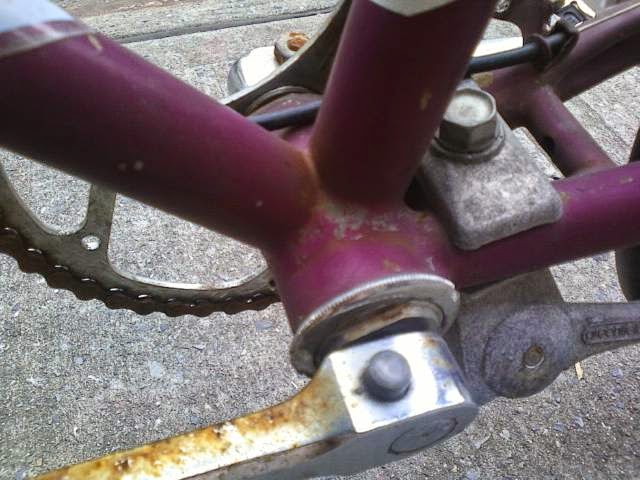Yesterday I saw this bike parked on Greenpoint Avenue:
Of course, I loved the color and was fascinated with the way the twin-lateral tubes curved from the seat tube to the rear dropout. It's not the first time I've seen such a configuration. Still, something told me there was something strange about the bike.
The Huret Allvit derailleur on the rear was more than likely original equipment. To paraphrase Frank Berto, it shifts poorly forever. The crankset also looked as if it had never been removed from the bike, although I suspect that, at some point, a chainguard was.
The shift lever was a plastic model from Simplex. Perhaps the derailleur was a replacement after all. Or maybe the shifter was. It was interesting, though, to see it on a brazed-on boss. But what I saw in front of it:
Or at the bottom bracket:
Perhaps my initial belief that this bike was French was wrong after all. Almost any Gallic ladies' or mixte bike of the era from which this bike appeared to be (the early 1970's or earlier) that wasn't made by a constructeur had lugs. Perhaps I was looking at a cleverly-disguised masterpiece.
Not surprisingly, the wheels and pedals were replacements. So, too, was the rear brake, I suspect:
Nearly all modern caliper brakes are mounted in a hole through the front fork crown or a bridge connecting the rear stays. At one time, calipers that clamped like the one in the photo were common. Later, they were used on bikes that originally were equipped with cantilever or rod brakes, which usually weren't drilled. But no one, it seems, made such brakes after the mid-1960's or thereabouts.
Stickers from Transportation Alternatives and other cycling-related organizations indicate that this bike is, or had been, ridden regularly. I wonder whether its rider has or had any idea of what he or she is or was riding.
Of course, I loved the color and was fascinated with the way the twin-lateral tubes curved from the seat tube to the rear dropout. It's not the first time I've seen such a configuration. Still, something told me there was something strange about the bike.
The Huret Allvit derailleur on the rear was more than likely original equipment. To paraphrase Frank Berto, it shifts poorly forever. The crankset also looked as if it had never been removed from the bike, although I suspect that, at some point, a chainguard was.
The shift lever was a plastic model from Simplex. Perhaps the derailleur was a replacement after all. Or maybe the shifter was. It was interesting, though, to see it on a brazed-on boss. But what I saw in front of it:
Or at the bottom bracket:
Perhaps my initial belief that this bike was French was wrong after all. Almost any Gallic ladies' or mixte bike of the era from which this bike appeared to be (the early 1970's or earlier) that wasn't made by a constructeur had lugs. Perhaps I was looking at a cleverly-disguised masterpiece.
Not surprisingly, the wheels and pedals were replacements. So, too, was the rear brake, I suspect:
Nearly all modern caliper brakes are mounted in a hole through the front fork crown or a bridge connecting the rear stays. At one time, calipers that clamped like the one in the photo were common. Later, they were used on bikes that originally were equipped with cantilever or rod brakes, which usually weren't drilled. But no one, it seems, made such brakes after the mid-1960's or thereabouts.
Stickers from Transportation Alternatives and other cycling-related organizations indicate that this bike is, or had been, ridden regularly. I wonder whether its rider has or had any idea of what he or she is or was riding.





